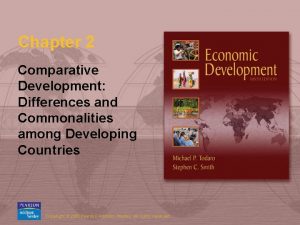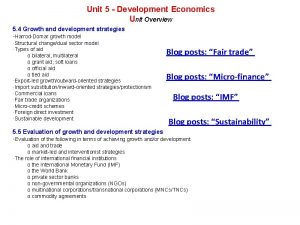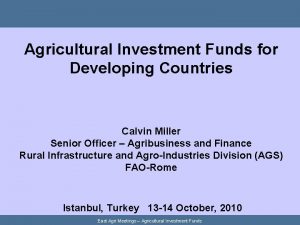Developing Countries Common and Diverse Characteristics Two Developing










- Slides: 10

Developing Countries Common and Diverse Characteristics

Two Developing Countries – They are the same in some ways but quite different in others.

• Of the 192 member states of the United Nations, only 52 are currently classified as high-income countries. In other words, 140 countries (73 per cent) are still considered developing economies. • The number of people living on less than US$1. 25 a day is projected to be 883 million in 2015, compared with 1. 4 billion in 2005 and 1. 8 billion in 1990. However, much of this progress reflects rapid growth in China and India, while many African countries lag behind

World Bank Income Classification (2019) • As of 1 July 2019, the World Bank income classifications by GNI per capita are as follows: • 1. Low income: $1, 500 or less • 2. Lower middle income: $1, 501 to $4, 500 • 3. Upper middle income: $4, 501 to $13, 500 • 4. High income: $13, 500 or more

Common Characteristics between Developing Countries • There are many common characteristics of developing countries – the list below is not meant to be an exhaustive one, but here these characteristics might include: • 1. Relatively low incomes per capita compared to richer advanced nations • 2. Lower absolute levels of productivity (labour and capital) • 3. A higher dependency on export incomes from primary commodities / low rates of export diversification • 4. They have a large share of the population living in rural areas and employed in agriculture

Common Characteristics between Developing Countries • 5. A higher than normal “informal” sector of the economy for example in partial subsistence farming • 6. Many industries in low-income developing countries tend to be some distance from the technological frontiers reached in rich advanced nations. • 7. Relatively fast growth of population and a younger average – giving a different shape to the population pyramid • 8. Weaknesses in critical infrastructure such as telecommunications, transport, ports, water and sanitation and institutions such as stable government, a well functioning civil service and money and capital markets

Diversity between Developing Countries • No two less economically developed countries are the same! • There is a huge amount of diversity between them • Think about some of the key structural economic differences between nations – for example:

Diversity between Developing Countries • 1. The size of an economy (i. e. population size, basic geography, annual level of national income) • 2. Historical background including years since independence from colonial rule • 3. Natural resource endowment • 4. The age structure of the population • 5. Ethnic and religious composition

Diversity between Developing Countries • 6. Relative size / importance of public and private sectors of the economy • 7. Structural of national output (e. g. primary, secondary, tertiary and quarternary sectors) • 8. Structure of international trade (both geographical and the commodity pattern of trade) • 9. Political stability, strength of democratic institutions, transparency of government

Diversity between Developing Countries • 10. Ethnic and gender equality and tolerance • 11. The ease with which new businesses can be created and sustained • 12. Other competitiveness indicators including the relative size and strength of highknowledge / high-technology industries
 Cellular vs plasmodial slime molds
Cellular vs plasmodial slime molds Major characteristics of developing countries
Major characteristics of developing countries Difference between developing and underdeveloped countries
Difference between developing and underdeveloped countries Five stages of economic growth
Five stages of economic growth Comparative education in developed countries
Comparative education in developed countries Harrod domar model
Harrod domar model Esrc wellbeing in developing countries que es
Esrc wellbeing in developing countries que es Agricultural investment funds for developing countries
Agricultural investment funds for developing countries Circus possessive form
Circus possessive form Working with culturally and linguistically diverse families
Working with culturally and linguistically diverse families Vanier institute of the family definition
Vanier institute of the family definition



















